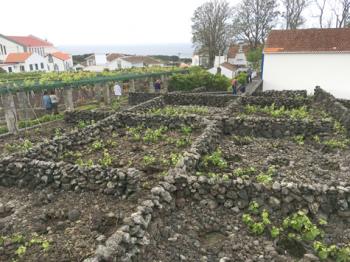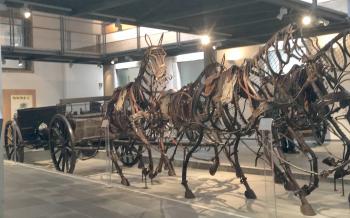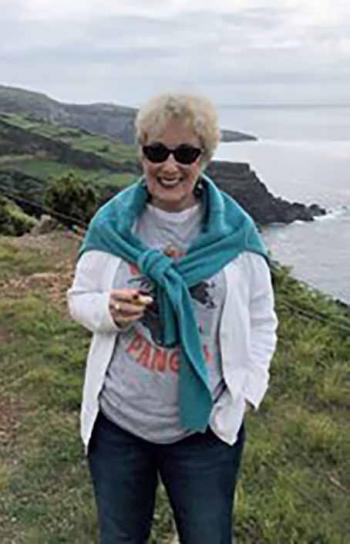Azores Getaways’ off-season deal
This item appears on page 27 of the September 2017 issue.
For the visit to our 105th destination (as defined by the Travelers’ Century Club’s list of countries and territories at www.travelerscenturyclub.org), we were seeking a cheap foreign trip that required less than an 8-hour plane ride. Coincidentally, Travelzoo.com was promoting an air-inclusive deal from Azores Getaways (Estrada de São Gonçalos, 235, 9500-343 Ponta Delgada, Azores, Portugal; phone, in the US, 617/934-8474, azores getaways.com/en).
The deal was very attractive. The Azores government’s pricing strategy unbundles local tours in order to encourage off-season tourism to the island of Terceira. They subsidized half the cost of the basic Azores package (and visas were not required).
For $749 per person, double occupancy, we got round-trip airfare from Boston on Azores Airlines; airport/hotel transfers, and a week’s stay for two in a 4-star hotel, including breakfasts and Wi-Fi. How can you beat that?!
Situated in the mid-Atlantic at about the same latitude as Washington, DC, the Azores — a Portuguese archipelago far southwest of the mainland — are four hours 40 minutes’ flying time from Boston. We opted to visit only Terceira, which is about 12 by 19 miles in size, with a population of 56,000.
We arrived at the Terceira Mar Hotel (www.bensaude.pt/terceira marhotel), in the town of Angra do Heroísmo, at 7 a.m., but our rooms were unavailable until 1 p.m. With no day rooms available, we found a couch and snoozed the morning away.
Facing an extinct volcano across a dramatic and highly photogenic water view, the 4-star hotel was pleasant, well staffed and clean. The breakfast was adequate (ignoring the slimy, undercooked bacon). The free Wi-Fi was excellent, and the Internet connection was wonderful, considering we were in the middle of nowhere. We also had free access to a fabulous gym pool that was “over the top.”
•
Terceira felt like a time warp to the 1950s. It was very peaceful, the people were lovely, and there was no hustle and bustle.
The weather stays almost constant year-round — a little rain, a little drizzle and a bashful sun. Temperatures during our visit, April 19-27, 2017, were moderate (60°-65°F), thanks to the Gulf Stream.
While there are no bathing beaches on Terceira, we found postcard-perfect volcanic cliffs at the ocean and frequent breathtaking views. Numerous ancient forts surround the island. Due to the island’s volcanic origin, the ground is saturated with rocks, so early farmers built lava-rock walls and separated properties with now-ubiquitous rock fences.
The land is a patchwork quilt of squares of green grass, where cows roam from one square to the next. The roads are 99% paved, but there is opportunity for off-road exploration. There was a notable absence of bugs and birds, even in the forests.
Local crafts were scarce, since most items come from mainland Portugal. Stores accepted only euros or credit cards, and money-changing was an issue, as commercial banks and hotels did not exchange dollars into euros. However, ATMs were plentiful.
Taxis were readily available and cheap, and buses were even cheaper, but walking up and down hills still held some health appeal.
Our rough Spanish was similar enough to Portuguese that it allowed us to get by, but English-speakers were prevalent.
Our traveling companions from the airplane included several affinity groups comprised of active and retired schoolteachers. They were a lot of fun, and we enjoyed bumping into them in various places on the small island. Most were aficionados of Travelzoo; without Travelzoo’s promotion, our hotel’s occupancy would probably have been much lower than 100%.
•
We considered renting a car for $35-$50 a day (including insurance), since the roads were first-class, but there were many narrow, one-way passages, so driving didn’t appeal to us. Instead, we focused on bus tours.
Our full-day bus tour ($65) with Azores Getaways began at 9 a.m. and traversed two-thirds of the island, taking us to 13 attractions. After a fabulous group lunch at the restaurant Os Moínhos (Rua Arrebaide, São Sebastião), we rode past open fields lined with stone fences.
We stopped at Algar do Carvão, a lava tube or volcanic vent in an extinct volcano in the middle of the island. This volcano exploded 3,000 years ago and again 2,000 years ago but has been quiet ever since. The chamber descends 300 feet in 338 steps to a lagoon at the bottom, where the temperature is always 53 degrees.
From inside the magma chamber, we were able to look up at the lava tube that would have belched hot lava in all directions. This was a fascinating natural attraction.
The second morning, on outings also purchased through Azores Getaways, we took a whale- and dolphin-watching cruise ($60) followed by a half-day bus tour ($40) that took in the rest of the island.
The Azores archipelago is one of the world’s largest whale sanctuaries. The whale-watching trip, run by OceanEmotion (www.ocean
emotion.pt), was particularly professional. The highlight was encountering a huge blue whale, the largest animal in the world. We trailed one for an hour as it blew frequently and dove deep underwater. The weather was a cool 60°, with very little wind, and the sea was in a calm, rolling state.
On the half-day bus tour, one of the stops was Queijo Vaquinha (Canada do Pilar 5, Angra do Heroísmo), where, aside from seeing the cured cheeses they produce, we experienced the widest selection of ice creams ever. Another stop presented eye-popping volcanic cliffs and dashing waters.
•
From our hotel, the center of the UNESCO World Heritage Site town of Angra do Heroísmo was a picturesque, 20-minute walk away. A modest seaside town, it was first known as Angra and became a city in 1534. It is now the major town on the island.
On a sleepy Sunday, we wandered and shopped in town. Coffeeshops offered delicious pastries and laid-back conversation. The “Visit Angra” iPhone app was a helpful virtual town guide.
We visited the museum in the former Convent de São Francisco, which had an elegant, informative world-class collection. Most notable was the architecture, the exhibition on the history of the Azores and a unique military display. The colorful public gardens in the town center can provide a relaxing visit.
The nearby museum at the Capitães Generais Palace offered a private tour but did not allow photography. The Church of Misericordia, at the waterfront, also had a guided tour. Most museums were closed on Monday but opened at 10 a.m. other days.
Most town roads were quaint cobblestone, while sidewalks were designer-inspired with decorative colored-stone geometry. You quickly appreciate why UNESCO invested in this historic town.
April 25, a Tuesday during our visit, was Freedom Day, a national holiday in Portugal. In Angra do Heroísmo’s central plaza, a parade was held with 19 marching bands, one from each of the surrounding towns. The bands were populated with young and old alike.
At the parade, we met the mayor (who went to college in Rhode Island) and complained about the lack of English signage for the museums. He explained that tourism on Terceira is only a 5-year-old business and that everyone knows where everything is!
•
With its own fishing fleet and agricultural production, it appears Terceira is self-reliant for food. The residents eat well, with fresh seafood and meats. We were not disappointed with any meals in the restaurants we visited.
Our dining experiences pointed to a high level of culinary talent and competition, resulting in varied menus and superb creative presentations. Best of all, the cost of fine, fresh meals was cheap, a third to one-half of what we would have paid at home.
One night, after a €7 (near $8) cab ride from our hotel, we arrived at Restaurante Beira Mar (Canada do Porto, 9700-555 São Mateus da Calheta), a large, well-known fish restaurant in a nearby coastal village. The food was delicious, very fresh and wonderfully served. At this restaurant, rated 4 to 5 stars online, our bill for two was merely $21, including drinks.
The local sports watched on Sunday afternoon TV were soccer and bullfighting. A regional tradition has a large bull running loose, restrained only by a rope half a block long (and usually limp) held by several men. We were surprised to find this exciting and entertaining. There was something magnetic about watching crazy citizens goading and daring a 2,000-pound bull running loose in the street.
On a frugal vacation with little flying time, you can get a taste of calm and quaint European island living for a week in the Azores. What a deal from Azores Getaways!
STEVE & MARCIA PLOTKIN
Newtown Square, PA

-itok=nOccvKHU.jpg)



